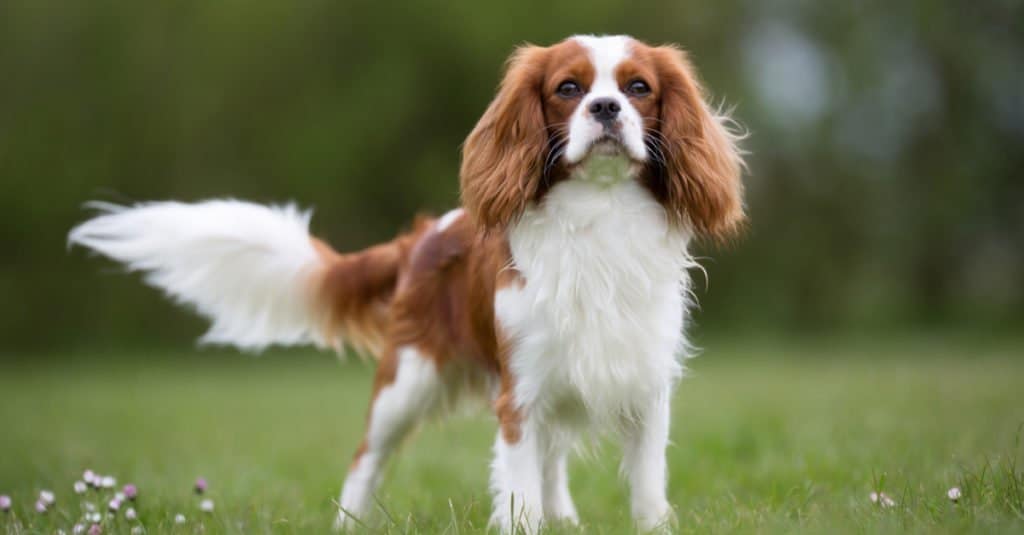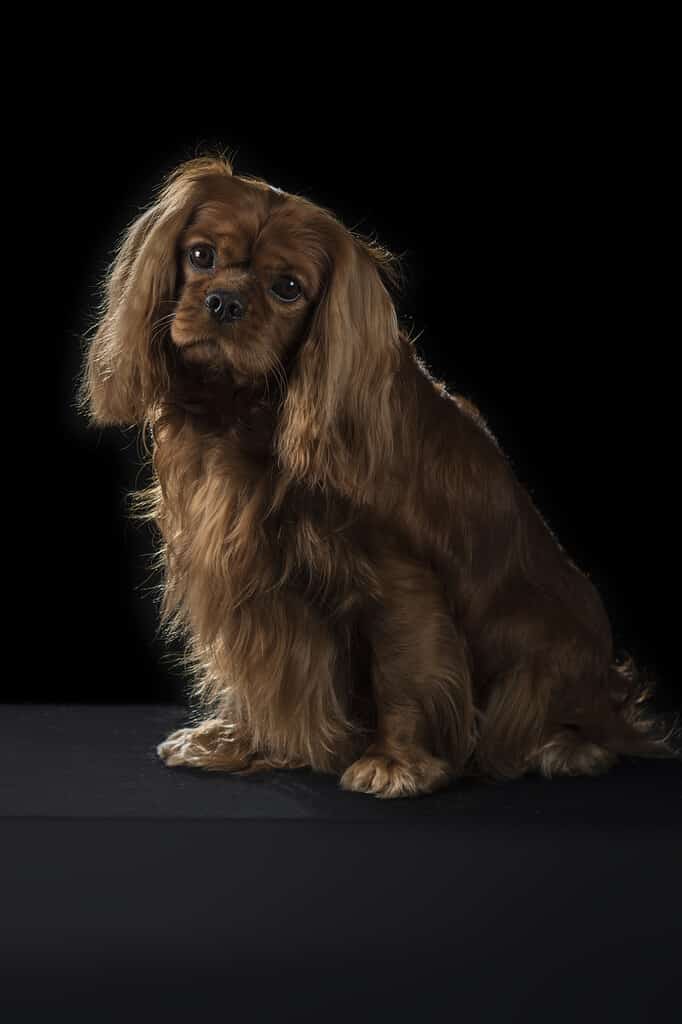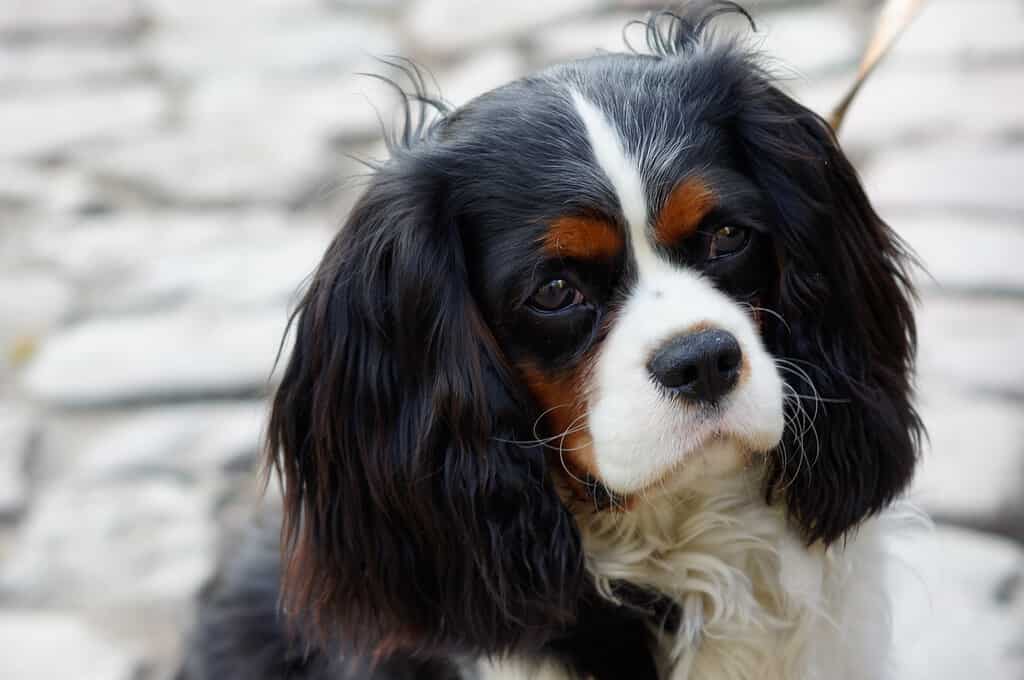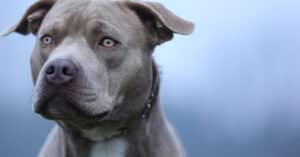The Cavalier King Charles Spaniel goes as far back as the Renaissance period and hails from the Toy Spaniel. Also, there is a legend that King Charles II allowed these dogs, by special decree, to enter parliament. These adorable dogs aren’t just charming in appearance. They are also endearing and have lovely personalities. In addition, they will happily settle down on your lap or take long walks, and they get along wonderfully with other dogs and children. Cavalier King Charles Spaniels have four standard colors and six substandard colors. So, there are ten colors overall. However, the substandard colors are not allowed to register for dog shows but are still beautiful.
1. Black and Tan
These colors are the rarest among Cavalier King Charles Spaniels. However, they are also the most well-known. These dogs will have a black body with tan highlights around the cheeks, eyebrows, and nails. Sometimes these tan markings can be found on the legs and inside the ears. Black and tan Cavalier King Charles Spaniels were alleged to be found in English courts. Lastly, these unique Cavaliers with white markings are considered quality-standard in dog shows.

Black and tan Cavalier King Charles Spaniels were alleged to be found in English courts.
©
2. Black and White
Black and white Cavaliers are also very rare. These Cavaliers have a black body with white on the feet, chest, and face. Also, these types of Cavaliers are very sought after among dog lovers and breeders. In addition, most black and white Cavaliers have tan markings somewhere on their bodies, which is common in many color variations.

Black and white Cavaliers are also very rare. These Cavaliers have a black body with white on the feet, chest, and face.
©Dora Zett/Shutterstock.com
3. Chocolate
Standard breed colors include chocolate, white, and chocolate as official colors. However, chocolate Cavaliers are tricolored dogs. Therefore, they are a combination of deep black, ruby, and white.
4. White
This variation is rare as the color comes from a genetic defect. What happens is that white puppies are born with a lack of pigment in their hair rather than having a gene that allows for that color. Also, in the case of Cavaliers, white dogs are actually albinos. There are many dog breeds, as well as humans, that carry the gene for albinism. Albino dogs will have pale eyes, white hair, and pale skin due to having no color pigment in their bodies. Additionally, these dogs will mostly not be bred because of the risk of passing on the gene. However, this gene mutation may happen in any litter.
5. Blenheim
This is the most common Cavalier King Charles Spaniel color. It gets its name from Blenheim Palace, where John Churchill, the Duke of Marlborough in the 18th century, raised this breed. Furthermore, this color variation is white with chestnut markings all over the body and around the eyes. Most Blenheim Cavaliers have a white muzzle and chestnut on their forehead. This chestnut marking on their forehead is called a “Blenheim Kiss.”
The “Blenheim Kiss” comes with a legend attached. It is believed that while the Duke of Marlborough was away at battle, his wife took comfort in the company of her Cavaliers. One of her dogs was carrying puppies, and she gently pressed her finger against the dog’s forehead. Later, after the war was won, and the duke returned home, he was welcomed by five puppies, each bearing unusual markings on their foreheads. Therefore, it was called the “Duchess Thumbprint” and later became known as the “Blenheim Kiss.”

This is the most common Cavalier King Charles Spaniel color. It gets its name from Blenheim Palace, where John Churchill, the Duke of Marlborough in the 18
thcentury, raised this breed.
©BIGANDT.COM/Shutterstock.com
6. Merle
This unusual color is caused by a variation in the dog’s dominant gene that will also give them other rare coat colors and blue eyes. Merle Cavaliers are considered not to be purebred. This is because the gene that codes for this color is not part of the breed standard. Furthermore, merle spots can cover the whole body or can be patterned. However, the ears are usually a solid color.
7. Tan
Tan color cavaliers are striking but not overly common. They have red hair. However, it is lighter than that of ruby-colored dogs. Also, tan Cavaliers are considered substandard, unlike ruby, one of the standard colors.
8. Ruby
Cavaliers only come in two solid colors, and ruby is one of them. Its name implies a deep red color. However, the ruby Cavalier King Charles Spaniel coat is more chestnut or auburn. This shade is relatively rare because most of these dogs have markings of some kind on their bodies. But the AKC (American Kennel Club) considers markings faults.

Cavaliers only come in two solid colors, and ruby is one of them. Its name implies a deep red color.
©Cavalier King Charles Spaniels, CC BY-SA 4.0 <https://creativecommons.org/licenses/by-sa/4.0>, via Wikimedia Commons – License
9. Tricolor
Cavaliers that are tricolor have a black or white base color with tan, white, or black markings. Also, they have markings around their eyes and ears, commonly divided by a blaze up the center of their muzzles. Interestingly, in the English court, the tricolor Cavaliers were demoted to “Prince Charles” Cavaliers because they were not a preferred color.

Cavaliers that are tricolor have a black or white base color with tan, white, or black markings.
©
10. White Markings
These white markings occur from the piebald gene. Additionally, this gene can appear on any other color of Cavalier. Sadly, white markings are considered substandard and will keep a dog from competing in AKC-sanctioned shows.
What Colors Are Considered the Breed Standard?
The only Cavalier King Charles Spaniel colors that are allowed to register with the American Kennel Club are ruby, tricolor, black and tan, and Blenheim. Therefore, all the other colors are considered substandard. Of these, Blenheim is regarded as the most common color. However, color standards are only necessary regarding official dog shows.
Health Issues Associated With Certain Colors
There are only two colors connected with health issues: white and merle. As stated, white Cavaliers have albinism and are at risk for particular health concerns, such as light sensitivity and skin cancer. Also, these dogs are born with eye anomalies that may affect their vision. Therefore, it is essential to give extra care to their eyes.
Merle Cavaliers are a product of crossbreeding and are not typical. This color variation requires one of the parents to carry the M allele on the PMEL gene. Cavaliers that carry this gene are at risk of developing problems associated with the allele. Some of these include large white spots on their skin, a declining number of cells in the inner ear that can cause hearing loss, and a decrease in retinal pigment that can lead to blindness. However, they can live long and happy lives with the proper healthcare. But they are not usually recommended for breeding.
Size
Cavalier King Charles Spaniels are sturdy but small dogs. They stand 12 to 13 inches and weigh between 13 to 18 pounds.
Personality
Like all dogs, Cavaliers can have a wide variety of personalities. Some are quiet and sedate, and others are lively and rowdy. Also, they are very social with people and other dogs. However, they might or might not bark when someone comes to the door, so they are not the best watchdogs. Additionally, they are great with kids and therefore make excellent family dogs.
Health
These dogs are generally healthy. However, like other breeds, they are prone to certain health problems. Not all Cavaliers will get these issues, but things to watch out for include:
- Episodic Falling: a condition that is often confused with epilepsy. However, here the dog remains conscious during the seizure. It is caused by a failure to relax the muscles. Symptoms are mild to severe and can appear as occasional falling episodes to seizure-like episodes that last for hours.
- Syringomyelia (SM): a condition affecting the brain and spine caused by a skull malformation. Symptoms of SM may vary from mild to severe pain and partial paralysis.
- Mitral Valve Disease (MVD): a common problem in cavaliers. It starts with a heart murmur and increases until the dog suffers from heart failure. Other dog breeds also suffer from this later in life. However, in Cavaliers, it can start as early as one year old.
- Patellar Luxation: a condition causing the knee joint to slide out of place, which causes pain.
- Keratoconjunctivitis Sicca (Dry Eye): caused by an autoimmune reaction to the dog’s tear glands. This leads to a reduction in tears. However, this condition can be treated with drops. But, if dry eye is left untreated, it can cause blindness.
- Hip Dysplasia: a hip joint deformity caused by environment, diet, or genetics. Dogs with hip dysplasia can lead normal lives with medication or surgery on the rare occasion.
The photo featured at the top of this post is © BIGANDT.COM/Shutterstock.com
Ready to discover the top 10 cutest dog breeds in the entire world?
How about the fastest dogs, the largest dogs and those that are -- quite frankly -- just the kindest dogs on the planet? Each day, AZ Animals sends out lists just like this to our thousands of email subscribers. And the best part? It's FREE. Join today by entering your email below.
Thank you for reading! Have some feedback for us? Contact the AZ Animals editorial team.






